Fishing
Hudson Bay is blessed with a wide variety of fish species and an abundance of clear water lakes, rivers, streams and stocked ponds. The local chapter of the Saskatchewan Wildlife Federation has worked to improve and expand fish stocks and habitat. Angling licenses are available from Macleods True Value, Northeast Service, The Co-op Gas Station and Saskatchewan Environment.
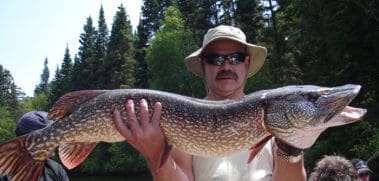
For more information regarding fishing in Saskatchewan click here.
Popular fishing spots around Hudson Bay
Armit River- Brook trout fishing.
Culldelsac Lake- Walleye, perch and jack fishing.
Dagg Creek- Campground: 6 tables, 4 barbecues, and picnic shelter.
Elbow Lake- Walleye, perch and jack fishing; services within 5 km, supply store, restaurant, gas station, dock and boat launch.
Elm Forest- Giant Elms and ferns with river nearby.
Fir River (Mile 16)- Brook trout fishing; 1 table, toilet, and shelter.
Fir River (Mile 21)- Brook trout fishing.
Greenbush- Campground: 2 tables, 1 barbecue, toilets, and camp kitchen.
Helldiver Channel- Pike and walleye fishing.
Isbister Lake- Walleye, perch and jack fishing; 3 tables, 3 barbecues, toilet, filleting shack, dock and boat launch.
McBride Lake- Campground, 22 tables, 22 barbecues, toilets, outfitter, fishing, beach, filleting shack, docks and boat launch.
Murphy Lake- Walleye, perch and jack fishing; toilet.
Parr Hill Lake- Campground, 12 tables, 12 barbecues, kitchen, 4 toilets, drinking water, fishing, filleting shack, dock and boat launch.
Peepaw Lake- 2 tables, 2 barbecues, fishing and a dock.
Regional Park- 2 km south of Hudson Bay, serviced campground, picnic sites, playground area, RV sewage disposal, showers, mist tunnels, trampoline and nature trail. Close to golf course and Red Deer Downs.
Saginas Lake- Walleye, perch and jack fishing; 2 tables, 2 barbecues, toilets, filleting table, dock and boat launch.
Smallfish Lake- Campground, Walleye, perch and jack fishing; 5 tables, 5 barbecues, toilets, dock and boat launch.
Spirit Lake- Campground, Walleye, perch and jack fishing; 6 tables, 6 barbecues, toilet ans services nearby including: supply store, restaurant, rental accommodations, gas station, outfitter, fish filleting shack, dock and boat launch.
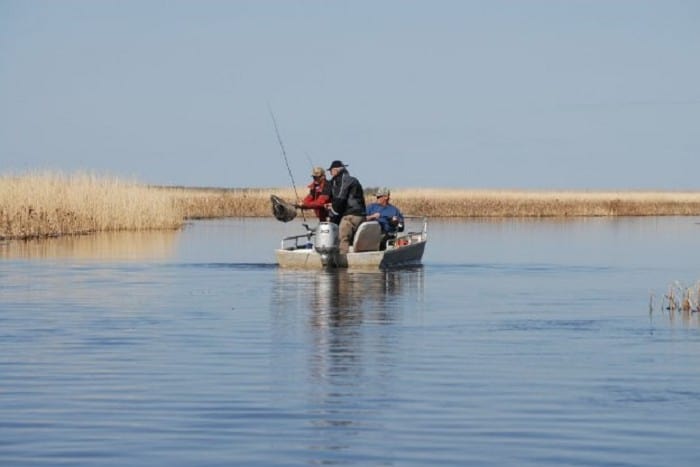
Fishing at Helldiver Channel
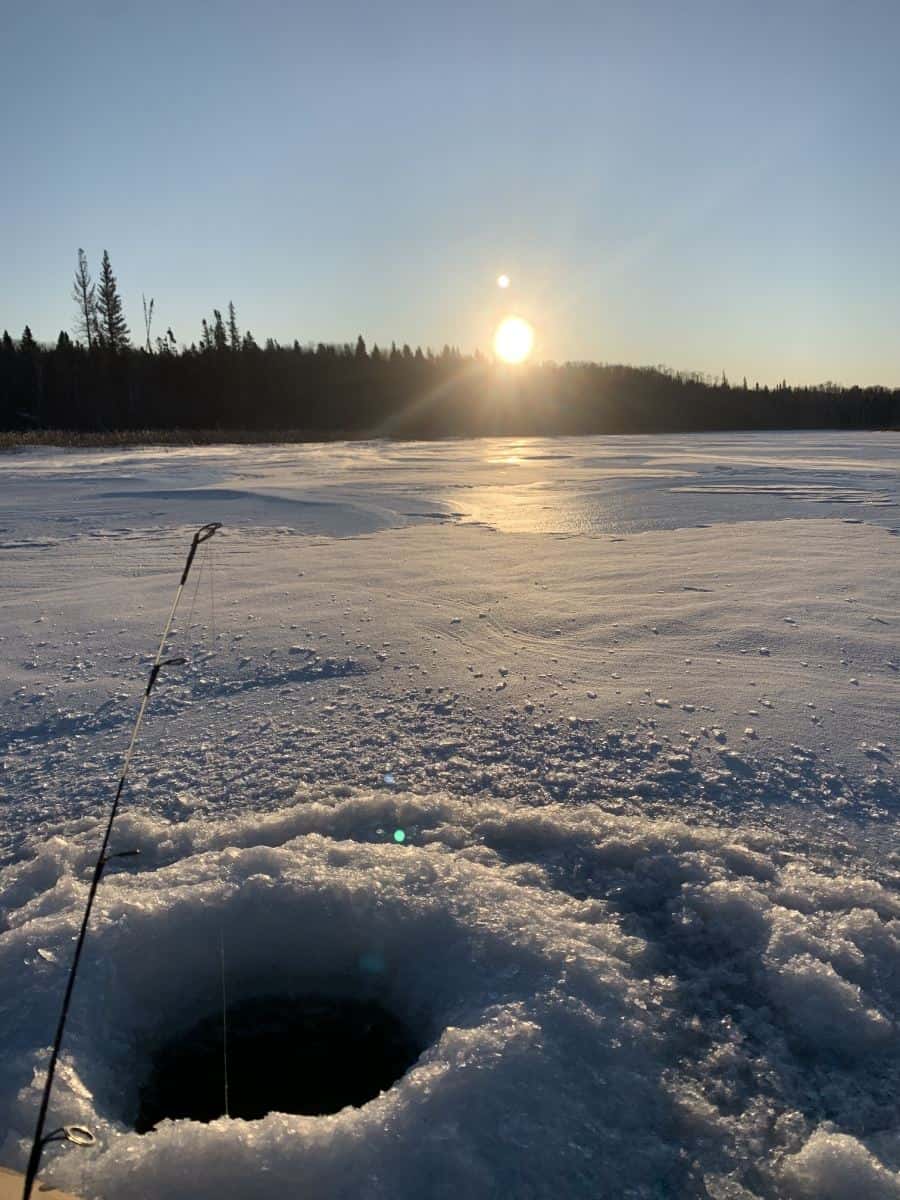
Ice Fishing Near Hudson Bay
Townsend Lake- Campground, Walleye, perch and jack fishing; 35 tables, 32 barbecues, supply store, restaurant, rental accommodation, gas station, drinking water, outfitter, 2 docks and boat launch.
Trout Pond- 2 km east of Hudson Bay, stocked with rainbow trout.
Woody Lake- Walleye, perch and jack fishing; services within 5 km, supply store, restaurant, gas station, outfitter, filleting shack, dock and boat launch.
Fishing for Brook Trout
Brook trout are beautifully colored, with a dark back, red spots with blue haloes, white bellies and orange fins. The tail is nearly square cut. They prefer shady areas, deep holes and “secret” places behind logs or rock ledges.
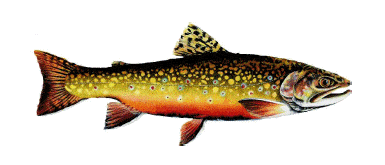
“Brookies” will go for a wet fly, a dry fly or a light spinner. Fishing proves best during mid-June and September; try the spinner at other times. The average weight is one pound in streams, and up to two pounds in lakes. Brook trout are a treat to eat and a pleasure to watch as they dart from one spot to another in the stream. The extensive rivers and streams in the area provides unlimited opportunities to fish for “brookies.”
Fishing for Perch
Perch is a small fish, weighing an average of one pound. The body is yellow or green, with a darker green back. The sides have broad vertical bars and the spines on the fins are sharp.
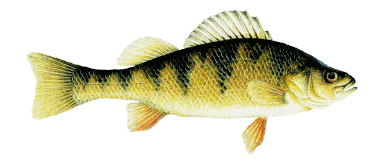
Perch are best caught using a variety of small spoons and light spinners. J hooks baited with minnows also work well. Perch are often found in schools close to shore. Although perch yield small amounts of meat, its quality and taste more than compensate for the volume.
The record size of 2 lbs 7.4 oz was caught in 1991 at Pagan Lake.
Fishing for Northern Pike
Northern pike, known also as Jack fish, are the most widely distributed sports fish in the province. It is a thrilling game fish to hook. Northern pike can be recognized by their large flattened jaws containing sharp long backward pointing teeth. The back and sides of the skin are greenish with yellowish-white spots and a heavy mucous coating giving the fish a slimy feel. The flesh or meat is firm, white and flaky, in spite of the numerous bones, Northern pike provide an excellent meal.
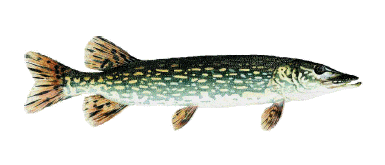
Northern pike generally prefer shallow weedy areas in lakes. You can fish for Northern pike using spinning or casting tackle. They can often be caught when other species are not biting. Large spoons, plugs and spinners work well during the summer while hooks jigged with minnows work better in winter.
The largest fish to be caught was taken in 1954 on Lake Athabasca which weighed 42 lbs 12 oz. The average Northern pike weighs 2 to 5 pounds.
Fishing for Rainbow Trout
Rainbow trout are stocked in a pond 2 miles east of Hudson Bay. They range in color from bluish to olive green on the back and silver on the sides. It’s the only Saskatchewan fish with black spots on the head, body and tail. Mature fish have a pink to reddish band along the sides.
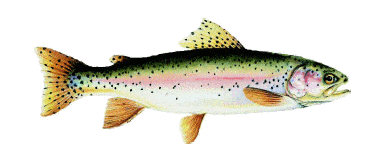
Since the average weight is 1 to 2 pounds, it is best to use a variety of small spoons and light spinners or fly tackle to catch rainbow trout. Lures with worms, corn or miniature marshmallows may also work.
The record size of rainbow trout was hooked in 1979 at Piprell Lake which weighed in at a whopping 19 lbs 12 oz. This fish was indeed an “exceptional” fish.
Fishing for Walleye
Walleye are also known as pickerel and are the most sought-after game fish in the Province. The fish have a characteristic golden color; their name comes from their large, silvery, almost opaque eyes. Walleye are at their best in large, shallow lakes where they feed throughout the day. In clearer waters, feeding is restricted to twilight and night time. Walleyes’ eyes are sensitive to bright light, so they usually seek shelter from sunlight. You can often find them under sunken trees or vegetation.
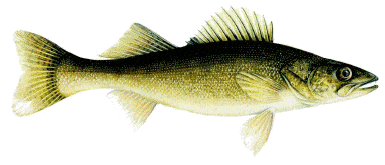
Walleye are often caught best near dawn and dusk, by fishing with spinners, spoons, plugs or jigs baited with minnows. When casting or trolling, try letting the lure sink to the bottom before retrieving it or trolling slowly. Jigging is also popular and successful in most areas. Walleye are not great fighters, usually heading to the bottom when hooked. This is one of the finest eating fish you’ll find in the province, especially when pan-fried fresh from the lake.
The largest Saskatchewan walleye was caught at Tobin Lake in 1995 and weighed in at 17 lbs 2 oz. The average weight of a walleye is 1 – 3 pounds.
